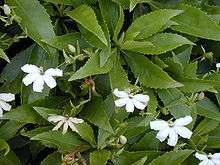Scaevola (plant)
| Scaevola | |
|---|---|
 | |
| Scaevola chamissoniana | |
| Scientific classification | |
| Kingdom: | Plantae |
| (unranked): | Angiosperms |
| (unranked): | Eudicots |
| (unranked): | Asterids |
| Order: | Asterales |
| Family: | Goodeniaceae |
| Genus: | Scaevola L. |
| Species | |
|
About 130, see List of Scaevola species | |
| Synonyms | |
|
Lobelia Mill. | |
Scaevola is a genus of flowering plants in the Goodenia family, Goodeniaceae. It consists of more than 130 tropical species, with the center of diversity being Australia and Polynesia.
Common names for Scaevola species include scaevolas, fan-flowers, half-flowers, and naupaka, the plants' Hawaiian name. The flowers are shaped as if they have been cut in half. Consequently, the generic name means "left-handed" in Latin. Many legends have been told to explain the formation of the naupaka's unique half flowers. In one version a woman tears the flower in half after a quarrel with her lover. The gods, angered, turn all naupaka flowers into half flowers and the two lovers remained separated while the man is destined to search in vain for another whole flower.[2]
Scaevola is the only Goodeniaceae genus that is widespread outside of Australia. In at least six separate dispersals, about 40 species have spread throughout the Pacific Basin, with a few reaching the tropical coasts of the Atlantic and Indian Oceans.
The Hawaiian Islands are home to ten Scaevola species, nine of which are endemic.[3] Eight of the indigenous species are the result of a single colonization event. Scaevola glabra and Scaevola taccada arrived separately to produce a total of three colonizations of Hawaii by Scaevola. Some of the endemic species are of hybrid origin.[4]
Beach Naupaka (Scaevola taccada synonym S. sericea) occurs throughout the Pacific and Indian Oceans and is considered an invasive species in Florida, USA, and in some islands of the Caribbean including the Cayman Islands[5] and the Bahamas. Beachberry or Inkberry (Scaevola plumieri) is widespread along the Atlantic coast of the tropical Americas and Africa; however, it is becoming rarer in areas where S. taccada is displacing native coastal plants.
Most Australian Scaevola have dry fruits and sprawling, herbaceous to shrubby habits. By contrast, nearly all species outside Australia have shrub habits with fleshy fruit making dispersal by frugivores easy.
The plant pathogenic sac fungus Mycosphaerella scaevolae was discovered on a Scaevola fan-flower.
Selected species

- Scaevola aemula R.Br. – Fairy Fan-flower or Common Fan-flower (Australia)
- Scaevola albida R.Br. – White Fan-flower (Australia)
- Scaevola amblyanthera F.Muell.
- Scaevola brookeana F.Muell.
- Scaevola chamissoniana Gaudich. Naupaka kuahiwi (Hawaii)
- Scaevola chanii K.M.Wong (Malaysia)
- Scaevola collaris F.Muell.
- Scaevola coriacea Nutt. – Dwarf Naupaka (Hawaii)
- Scaevola crassifolia Labill. – Thick-leaved Fan-flower (Australia)
- Scaevola enantophylla F.Muell.
- Scaevola floribunda A.Gray (Fiji)
- Scaevola gaudichaudiana Cham. – Mountain Naupaka, Naupaka kuahiwi (Oʻahu and Kauaʻi in Hawaii)[6][7]
- Scaevola gaudichaudii Hook. & Arn. – Ridgetop Naupaka (Hawaii)
- Scaevola glabra Hook. & Arn. 'Ohe naupaka (Hawaii)
- Scaevola gracilis
- Scaevola hookeri (de Vriese) F.Muell. ex Hook.f. – Creeping Fan-flower or Alpine Fan-flower
- Scaevola kilaueae O.Deg. – Huahekili uka (island of Hawaiʻi)
- Scaevola muluensis K.M.Wong (Malaysia)
- Scaevola macrophylla
- Scaevola oldfieldii F.Muell.
- Scaevola oxyclona F.Muell.
- Scaevola parvifolia F.Muell. ex Benth.
- Scaevola phlebopetala F.Muell.
- Scaevola platyphylla Lindl. – Broad-leaved Fanflower (Western Australia)
- Scaevola plumieri (L.) Vahl – Beachberry, Waxy Bush, "inkberry" (Pantropical)
- Scaevola porocarya F.Muell.
- Scaevola procera Hillebr. – Forest Naupaka, Naupaka kuahiwi (Molokaʻi and Kauaʻi in Hawaii)
- Scaevola ramosissima (Sm.) K.Krause
- Scaevola socotraensis H.St.John (Yemen)
- Scaevola spinescens R.Br. – Murrin murrin, poontoo, maroon bush, spiky fanflower (Australia)
- Scaevola taccada (Gaertn.) Roxb. – Beach Naupaka, Naupaka kahakai (Hawaiian); ngahu (Tongan) (Pantropical)
- Scaevola verticillata Leenh. (Malaysia)
Notes
- ↑ "Genus: Scaevola L.". Germplasm Resources Information Network. United States Department of Agriculture. 2007-10-05. Retrieved 2010-09-21.
- ↑ Hammer, Roger (Spring 1998). "Postcards from Paradise: Separated Lovers and the Beach Naupaka" (PDF). Wildland Weeds: 7–8.
- ↑ "Selected Plants Found on Hawaii's Offshore Islets". Offshore Islet Restoration Committee.
- ↑ Howarth, Dianella G.; David A. Baum (2005). "Genealogical evidence of homoploid hybrid speciation in an adaptive radiation of Scaevola (Goodeniaceae) in the Hawaiian Islands". Evolution. 59 (5): 948–961. doi:10.1111/j.0014-3820.2005.tb01034.x. PMID 16136795.
- ↑ DaCosta-Cottam, M.; Olynik, J., Blumenthal, J., Godbeer, K.D., Gibb, J., Bothwell, J., Burton, F.J., Bradley, P.E., Band, A., Austin, T., Bush, P., Johnson, B.J., Hurlston, L., Bishop, L., McCoy, C., Parsons, G., Kirkconnell, J., Halford, S. and Ebanks-Petrie, G. (2009). "Cayman Islands National Biodiversity Action Plan 2009" (PDF). Cayman Islands Government. Department of Environment. Cite uses deprecated parameter
|coauthors=(help) - ↑ Little Jr., Elbert L.; Roger G. Skolmen (1989). "Naupaka kuahiwi, mountain naupaka" (PDF). Common Forest Trees of Hawaii (Native and Introduced). United States Forest Service.
- ↑ Scott, Susan. 1991. Plants and Animals of Hawaii. Bess Press.
References
- Howarth, Dianella G.; Gustafsson, Mats H.G.; Baum, David A. & Motley, Timothy J. (2003): Phylogenetics of the genus Scaevola (Goodeniaceae): implication for dispersal patterns across the Pacific Basin and colonization of the Hawaiian Islands. Am. J. Bot. 90(6): 915-213. PDF fulltext Supplemental data
External links
![]() Media related to Scaevola at Wikimedia Commons
Media related to Scaevola at Wikimedia Commons
![]() Data related to Scaevola at Wikispecies
Data related to Scaevola at Wikispecies
- Hawaiian Native Plant Propagation Database
- "Beach Naupaka: Opera by the Sea" Article by Shannon Wianecki in Maui No Ka 'Oi Magazine, Vol.15 No. 5 July 2011.
